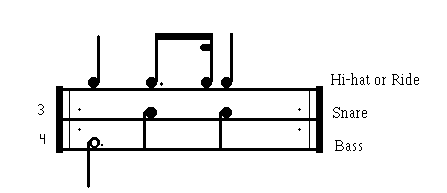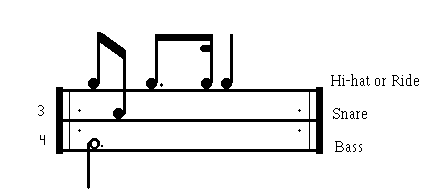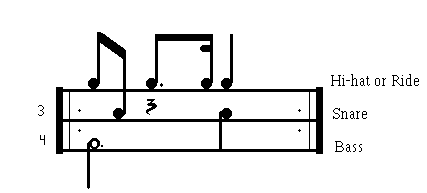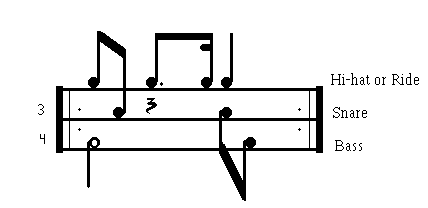


We will start with a simple Swing Waltz then stair-step or graduate slowly into some of the more complex forms of the rhythm.

![]() This is a simple "Swing" Waltz.
You may hear it most often with simple C&W tunes or many soft romantic, pop-ballads.
This basic pattern is a total bore for most drummers, though it is the one we wind up being forced to play most often.
This is a simple "Swing" Waltz.
You may hear it most often with simple C&W tunes or many soft romantic, pop-ballads.
This basic pattern is a total bore for most drummers, though it is the one we wind up being forced to play most often.

![]() Now, we toss in a quick syncopation on the snare,
in-between the 1st and 2nd cymbal notes. We are leading up to something a little more interesting.
Now, we toss in a quick syncopation on the snare,
in-between the 1st and 2nd cymbal notes. We are leading up to something a little more interesting.


![]() There are many ways to vary the beat. Here is an
example showing an additional bass note with each repetition.
There are many ways to vary the beat. Here is an
example showing an additional bass note with each repetition.
JAZZ WALTZ is unique in that every 6/8 or 8th triplet Blues beat could conceivably contain two repetitions of waltz. It is very common for jazz musicians to build interesting arrangements based on this principle. You will hear many jazz tunes that jump or shift from Blues into Jazz Waltz and back while maintaining the same general tempo.
FILLS:
When dropping fills into the above Jazz Waltz pattern it may be best to
begin your fills on the 1st count of the measure as you are learning. Use any roll pattern you wish. Play three groups of your roll beginning
on the first count of the bar. This will bring you out to the first count of the next bar. Later, you may experiment
with dropping fills on the 2nd or 3rd count in the measure. It really doesn't matter
what we play as a fill, nor where we begin. The trick is to never lose track of the count.
Video: For almost all handheld devices and other browsers.
![]() Copyright Bill Powelson 1996-2008-2014 @ all rights reserved.
Copyright Bill Powelson 1996-2008-2014 @ all rights reserved.

![]()
Musical Time - Finite to Infinity:
Finite to Infinity:
Learn to easily jam and play music comfortably within any odd or even time signature. This material isn't currently taught in music-theory classes, yet it is simple enough for grade-school students. Discover more than 18 quintillion unique and different (modern music) song-beat structures.Discover the (lost) 500 year-old enigmatic secrets hidden within the current time-signature system. Seven short mesmerizing and easy-to-follow lessons will lead you quickly and easily towards (musical-time) guru status. You will learn to visualize (read, write or feel) the existence This should lead directly to the e-book.

This very informative little booklet will amaze you with hundreds of valuable tips and insider secrets! HOW TO: Purchase old/used drumsets for pennies and resell them for decent profits.